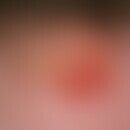Synonym(s)
HistoryThis section has been translated automatically.
DefinitionThis section has been translated automatically.
Rare clinical picture, now controversial as an entity, originally described as "obligate cutaneous paraneoplasia" in carcinomas of the mamma (6%), the female genital, the pharynx, the bronchi (in 50% of cases), the oesophagus or the stomach. The exanthematic skin changes can precede a tumor disease by 4-8 months (see below notes). In the meantime, the erythema gyratum repens has also been described in non-tumorous diseases (e.g. rheumatoid arthritis).
You might also be interested in
EtiopathogenesisThis section has been translated automatically.
Unclear. Immunological reactions to various antigens (tumor products 70% of patients, infection-associated antigens, drugs/viral infections), which lead to the characteristic, but not specific, morphological pattern of the skin, are being discussed. Recently, cases have been associated with COVID-19 infection (Peres G et al. 2021; Castro Silva R et al. 2021) and SARS-CoV-2 vaccination (Chiquito D et al. 2022).
ManifestationThis section has been translated automatically.
Occurring mainly in adults, usually 40th-60th l yr; m:f=2:1;
LocalizationThis section has been translated automatically.
Clinical featuresThis section has been translated automatically.
Anular, garland-shaped or spirally intertwined, slightly infiltrated, always marginal erythema and plaques. Possibly also urticarial, 1-2 cm wide, rapidly changing erythema stripes with marginal, somewhat raised scaling.
The skin changes are often described as "wood grain-like" or as "zebra stripes (red-white zebra)", which would distinguish them from the clinically similar changes of erythema anulare centrifugum . To what extent this morphologic feature can be considered a specific feature of this disease remains questionable.
Furthermore, flat, scaly erythema on the face, neck, hands and feet. Small spotted recurrences in the healed areas.
In some patients, additional palmoplantar keratoses or an acquired ichthyosis existed.
LaboratoryThis section has been translated automatically.
Hematoeosinophilia is detectable in 50% of cases.
HistologyThis section has been translated automatically.
Uncharacteristic perivascular infiltrates of lymphocytes, monocytes, histiocytes and sometimes also eosinophilic leukocytes. Apoptotic (dyskeratotic) epithelia can be detected in the surface epithelium. The keratinization is orthofocal parakeratotic. The histological picture corresponds to that of erythema anulare centrifugum.
Direct ImmunofluorescenceThis section has been translated automatically.
In direct immunofluorescence, C3, C4, or IgG can occasionally be detected at the dermo-epidermal junction.
Differential diagnosisThis section has been translated automatically.
TherapyThis section has been translated automatically.
External therapyThis section has been translated automatically.
Note(s)This section has been translated automatically.
In a summary evaluation of the relevant literature with 112 cases of EGR, malignant internal neoplasms were detected in only 52% of the cases according to Rongioletti F et al (2014). 48% of the cases were evaluated as non-paraneoplastic. Thus, the classification of erythema gyratum repens as a morphologic entity and as an obligate paraneoplasia must be doubted. Rather, it has to be classified as a "non-specific réaction cutanée" to different systemic processes or as a particular morphological pattern of different figured skin diseases (intimal changes in cutaneous T-cell lymphoma or in pityriasis rubra pilaris - Almaani N et al. 2011) or as a drug reaction. Furthermore, EGR has been described in association with rheumatoid arthritis or also as para- or post-infectious (e.g. in pulmonary tuberculosis and leprosy).
Case report(s)This section has been translated automatically.
The 65-year-old woman had noticed barely itchy, red plaques for 6 months, which developed within weeks from 0.5-1.0 cm large solid plaques to large anular or circinate, slightly infiltrated, linear plaques.
Based on the clinical picture, a suspected diagnosis of erythema gyratum repens was made. A subtle examination revealed no evidence of an internal malignancy. The laboratory was completely unremarkable.
Histology: Uncharacteristic perivascular infiltrates of lymphocytes, monocytes, histiocytes and scattered eosinophilic leukocytes. Focal parakeratosis.
Course: The HV regressed completely after 6 months of local therapy. A further clinical examination did not reveal any evidence of an internal tumor.
LiteratureThis section has been translated automatically.
- Almaani N et al. (2011) Erythema gyratum repens associated with pityriasis rubra pilaris. Clin Exp Dermatol 36:161-164.
- Bryan ME et al. (2003) Erythema gyratum repens in a case of resolving psoriasis. J Drugs Dermatol 2: 315-317
- Castro Silva R et al. (2021) Erythema gyratum repens after COVID-19. J Eur Acad Dermatol Venereol 35: e859-e861.
- Chiquito D et al. (2022) Erythema gyratum repens after COVID vaccination. J Eur Acad Dermatol Venereol 36: e520-e522.
- Endo Y et al. (2013) Erythema gyratum repens preceding the onset of rheumatoid arthritis. Eur J Dermatol 23:399-400
- Galán-Gutiérrez M, Martínez-Peinado CM, Ruiz-Villaverde R. Erythema gyratum repens: Not always a paraneoplastic disease. Rev Clin Esp 214:425-427
- Gammel JA (1953) Erythema gyratum repens. Arch Derm Syph 66: 494-505
- High WA et al. (2003) Superficial gyrate erythema as a cutaneous reaction to alendronate for osteoporosis. J Am Acad Dermatol 48: 945-946
- Holcomb M et al. (2012) Erythema gyratum repens-like eruptions with large cell transformation in a patient with mycosis fungoides. Int J Dermatol 51:1231-1233
- Lo Schiavo A et al. (2012) Erythema gyratum repens and rheumatoid arthritis: an unrecognized association? Indian J Dermatol Venereol Leprol 78:122
- Nagase K et al. (2014) CD4/CD8 double-negative mycosis fungoides mimicking erythema gyratum repens in a patient with underlying lung cancer. Acta Derm Venereol 94:89-90
- Marchetti MA et al. (2013) Pityriasis rubra pilaris treated with methotrexate resolving with an erythema gyratum repens-like appearance. J Am Acad Dermatol 69:e32-3
- Peres G et al (2021) Erythema gyratum repens following COVID-19 infection. Int J Dermatol 60, 1435-1436.
- Rongioletti F et al. (2014) Erythema gyratum repens is not an obligate paraneoplastic disease: a systematic review of the literature and personal experience. J Eur Acad Dermatol Venereol 28:112-115.
- Rongioletti F et al. (2012) Erythema gyratum repens induced by pegylated interferon alfa for chronic hepatitis C. Arch Dermatol 148:1213-1214
- Sohl S et al. (2009) Wood grain-like exanthema with central paling on the lower extremity. JDDG 7: 261-262
Incoming links (7)
Annular dermatoses; Betamethasone valerate emulsion hydrophilic 0,025/0,05 or 0,1 % (nrf 11.47.); Erythema; Erythema anulare centrifugum; Lung diseases, skin changes; T-cell prolymphocytic leukemia; Triamcinolone acetonide cream hydrophilic 0,025/0,05/0,1% (nrf 11.38.);Outgoing links (10)
Betamethasone valerate; Betamethasone valerate emulsion hydrophilic 0,025/0,05 or 0,1 % (nrf 11.47.); Erythema anulare centrifugum; Glucorticosteroids topical; Paraneoplasia, cutaneous; Pityriasis rubra pilaris (adult type); Psoriasis erythema anulare centrifugum-like; Scale ; Triamcinolone acetonide; Triamcinolone acetonide cream hydrophilic 0,025/0,05/0,1% (nrf 11.38.);Disclaimer
Please ask your physician for a reliable diagnosis. This website is only meant as a reference.












